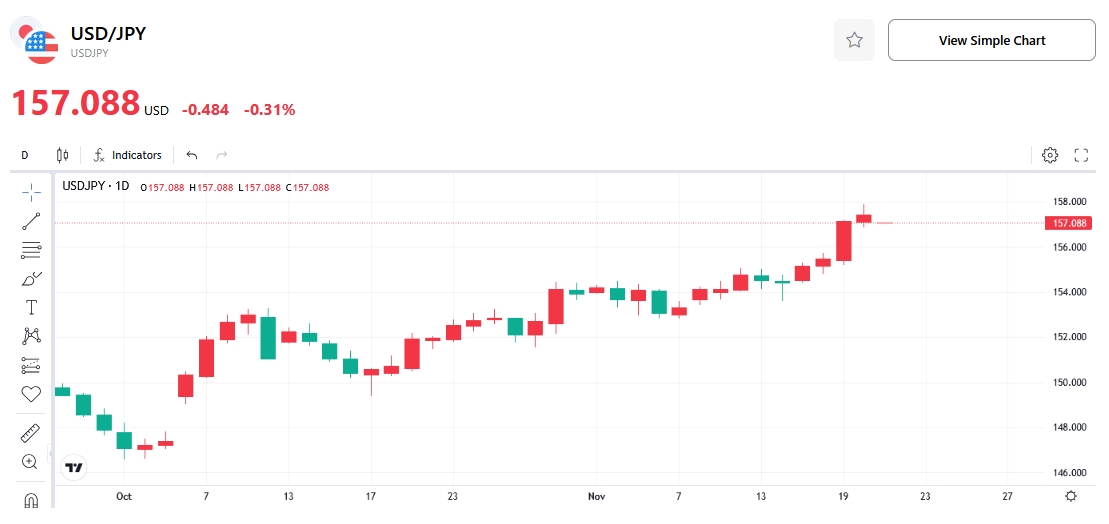"Sell Japan" Overpowers the "Takanichi Trade": Three Keys to a Turnaround
TradingKey - Concerns over Japan's substantial fiscal stimulus plans and the supply-demand dynamics of Japanese government bonds (JGBs) have triggered a sharp plunge in the nation's debt, sparking intense market debate. Compounded by a slump in U.S. technology stocks, Japanese markets are currently experiencing a sustained "triple whammy" of declines across equities, bonds, and the yen.
This "sell Japan" narrative has overshadowed the positive sentiment that followed the "Takaichi trade" in late October. Will this trend reverse now that Japan has approved a ¥21.3 trillion fiscal stimulus package?
As November 2025 began, global capital markets entered a period of turbulence, stretching from the U.S. to Japan. Japanese tech stocks slumped due to a sharp decline among their U.S. counterparts, with the Nikkei 225 index falling over 7% month-to-date and almost erasing gains seen after Takaichi's election as Japan's first female prime minister in late October.
During this period, the U.S. dollar against the Japanese yen (USD/JPY) rose by approximately 2%, pushing the yen to a 10-month low, while yields on Japan's ultra-long-term government bonds surged to historic highs.
Positioned as "Abenomics 2.0," the Sanae Takaichi trade similarly advocates for monetary easing and fiscal stimulus, which theoretically should weaken the yen and boost Japanese equities. However, widespread concerns have led to a somewhat unusual combination of yen weakness and a pullback in Japanese stocks.
Some analysts suggest that the honeymoon period for the Sanae Takaichi trade is over, with many now trapped in a "sell Japan" predicament.
The central contention surrounding the Takaichi administration's massive fiscal stimulus plan is whether such a large package, the biggest since the COVID-19 pandemic, is still necessary. Furthermore, there are doubts about the market's capacity to absorb a substantial supply of government bonds without the Bank of Japan's support as a major buyer.
Goldman Sachs has warned that Japan's bond market is poised for a return of fiscal risk premiums as investors remain cautious about a stimulus package exceeding expectations. This, in turn, will pressure long-term sovereign debt and the yen.
The accelerated depreciation of the yen is largely attributable to the Bank of Japan's (BOJ) inactive stance on the current situation. The BOJ's ability to raise interest rates is constrained by the Takaichi government, while the Federal Reserve is struggling to cut rates amid strong internal divisions and a "data vacuum."
Moreover, as the yen approaches the next psychological threshold of 160, senior Japanese government officials have yet to discuss currency intervention.
Sumitomo Mitsui Trust Bank stated that the foreign exchange market is witnessing a "sell Japan" trend.
Is the "Sell Japan" Trend Nearing an Inflection Point?
However, after the Japanese Cabinet finalized a ¥21.3 trillion ($135.4 billion) economic stimulus package on Friday, November 21, discussions have turned more optimistic regarding the fiscal plan's potential to drive long-term growth, efforts to curb inflation prompting monetary easing, and the prospect of Japan undertaking currency intervention.
The new fiscal package, representing a 27% increase from the previous year, marks the largest stimulus plan since the COVID-19 pandemic. Of this, ¥11.7 trillion is allocated for price relief measures, constituting the largest component of the package.
This underscores the Japanese government's determination to tackle persistent high inflation. Such painful price pressures have been a significant factor in the downfall of former Prime Minister Shigeru Ishiba.
Data released Friday showed that the annual core consumer price index (CPI), excluding fresh food, stood at 3%, marking 43 consecutive months above the Bank of Japan's 2% target – the longest such streak since 1992.
Should the Takaichi government ultimately alleviate price pressures, the likelihood of Japan maintaining its current policy or even implementing further monetary easing could increase, making interest rate hikes a thing of the past.
As the yen's exchange rate slid to levels that could trigger "currency intervention," the Japanese government has been compelled to act. Chief Cabinet Secretary Minoru Kihara stated on Thursday that the yen's sudden and one-sided fluctuations are concerning, emphasizing the importance of exchange rates remaining stable and reflecting economic fundamentals.
However, economists at Nomura Research noted that the lack of a strong stance against the yen's depreciation disappointed the market, potentially leading to further dollar gains and yen weakness.
Japanese Finance Minister Satsuki Katayama also conveyed deep concerns about the yen's depreciation on Friday, indicating that currency intervention would be considered. The Asahi Shimbun reported that this warning against market volatility was more assertive than previous statements.
As of this writing, the USD/JPY exchange rate was down 0.31% for the day, trading at 157.088. While the pair has risen 4% over the past month, its year-to-date change remains modest. Meanwhile, Japan's 10-year government bond yield retreated to 1.779% from Thursday's 1.816%.

USD/JPY Exchange Rate Trend, Source: TradingKey
While Japanese equities remain weak due to spillover effects from the U.S. stock market, many investors believe that the Takaichi government's economic plans will still benefit Japanese assets in the long term.



